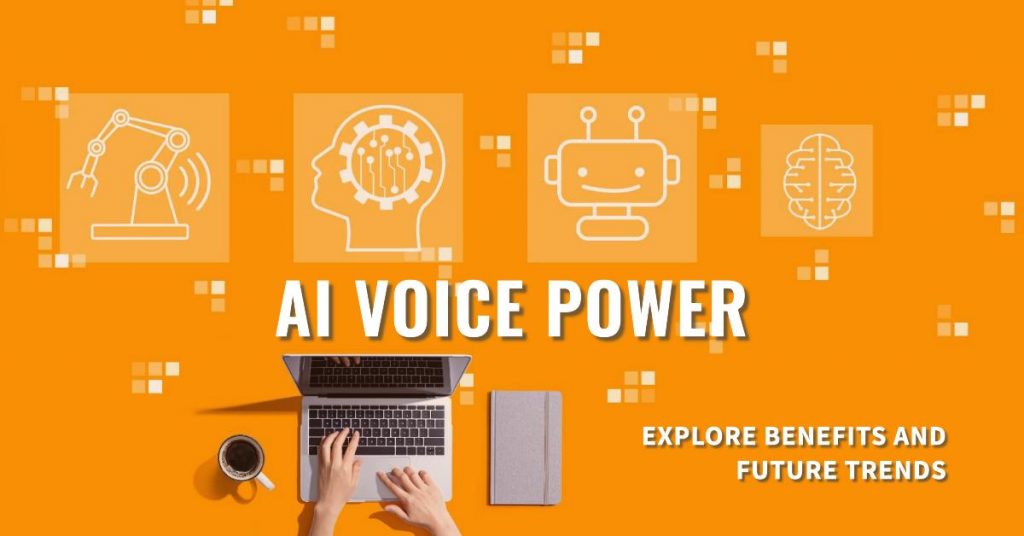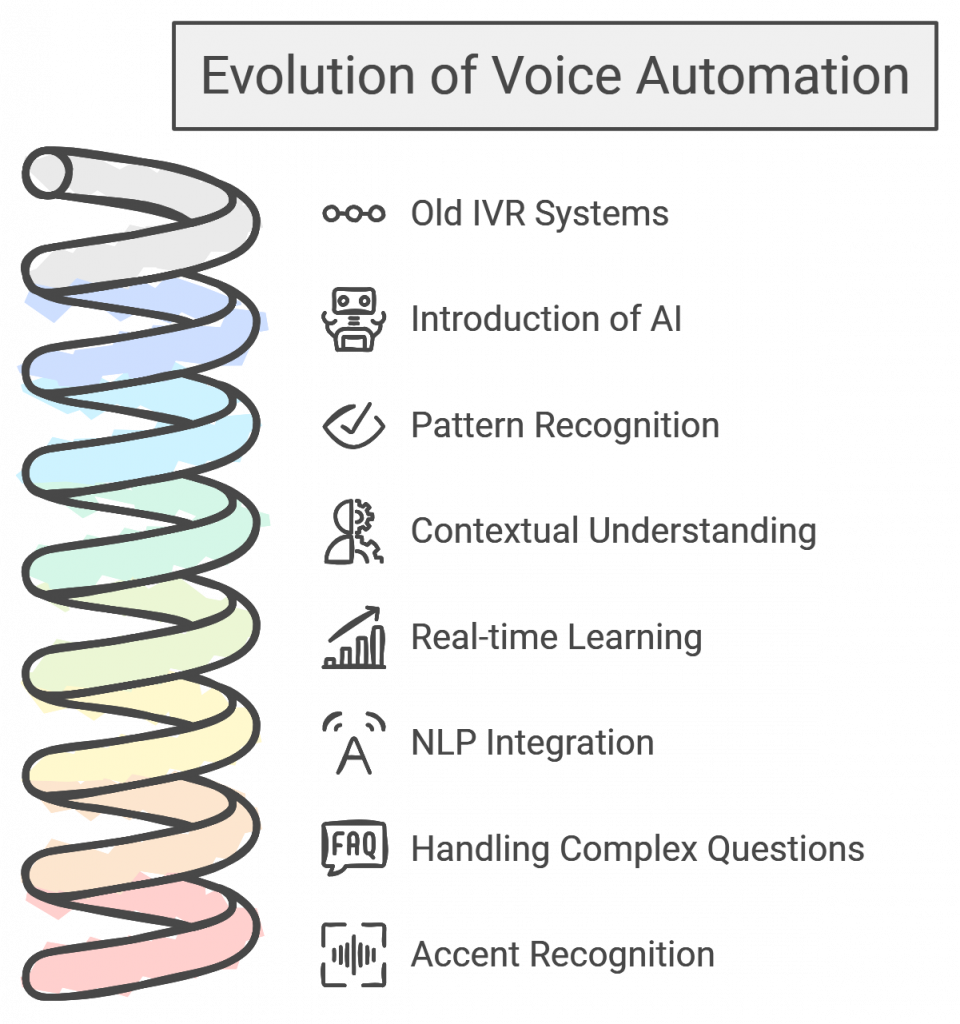The way businesses communicate has changed a lot. Remember when pressing “1” for service or “2” for sales was a new thing? Today, AI voice automation is way beyond that. It lets people have natural conversations that understand context, emotion, and what you really mean.
Voice bots used to only give basic answers, but now they are advanced AI systems that can handle complicated conversations. This change is helping businesses connect better with their customers, moving from stiff, menu-driven systems to more natural, human-like conversations.

Today’s voice automation uses AI and natural language processing to understand and respond to questions accurately. These systems don’t just answer calls anymore—they actually have meaningful conversations, solve problems, and sometimes even know what you need before you ask.
For businesses, using voice automation is super important to stay ahead of the competition. As customers expect more and want service 24/7, old ways of communicating aren’t enough. Companies using emotional AI are seeing big improvements in customer happiness and efficiency.
💡 Modern Voice Automation: More Than Basic Phone Menus

From Simple Menus to Real Conversations
Modern AI-powered customer service systems are more like helpful conversation partners than the old phone menus. They understand regular speech, change how they respond based on how a customer feels, and learn from each conversation to get better. These systems can also handle several topics in one conversation, just like a human agent.
Today’s voice automation uses advanced pattern recognition to understand customers really well. It connects easily with existing business systems, so it works for companies of any size. At the core is Natural Language Processing (NLP), which helps machines understand what people mean, handle complex questions, and deal with different accents and ways of speaking, making the conversation feel smooth.
🔧 Key Technologies That Make Voice Automation Work

Natural Language Understanding (NLU) helps voice systems understand the details in what customers say, making the conversation feel more like talking to a smart assistant rather than a machine. Machine learning helps these systems keep improving, learning from every conversation to provide better answers and even guess what a customer might need next.
Voice cloning and voice synthesis technology create consistent voices that can change tone or language when needed. This makes conversations more engaging and helps keep a brand’s identity strong. Plus, tools that analyze customer emotions can spot frustration early on, allowing the system to adjust or send the call to a human agent if needed.
📈 How Voice Automation Helps Businesses
AI voicemail systems and automation tools provide many real benefits. Businesses can cut costs by 40-60%, handle multiple conversations at the same time, and offer service around the clock without needing extra staff. These systems can also easily handle high demand during busy times, keeping service quality consistent.
Customers benefit from quick answers and personalized help. The ability to provide support in different languages also makes the experience better. On the business side, companies get valuable information from detailed data, helping them make better decisions and see trends early.
Voice automation isn’t just about new technology; it’s about changing how businesses talk to customers. By using these tools, companies can lead in customer service while also making their operations more efficient.
🏢 Real-World Success Stories: AI Voice Automation in Action

🎯 Changing Customer Service with AI
Using customer service AI is changing the way businesses talk to their customers. Modern AI systems can answer questions instantly and know when to ask a human for help with harder problems. These systems remember customer history and can handle conversations in different languages, making them great for global use.
These AI systems are also very good at managing support tickets. They can create and organize tickets, send them to the right person, and give real-time updates to customers and staff. They even keep track of problems before they get worse.
The way these systems manage calls is also impressive. They make sure calls go to the best person or department by using skills-based routing. During busy times, they balance the workload to keep everything running smoothly, and they keep all the information intact even if a call is transferred.
One of the most important changes is how follow-ups are handled. These systems schedule check-ins, send satisfaction surveys, confirm that problems are solved, and send personalized follow-up messages, making sure no customer is forgotten.
🏥 Improving Patient Care with Voice AI
Healthcare-specific AI solutions are making patient communication and care management much easier. These smart systems help manage appointments from booking to insurance checks and sending pre-visit instructions. They even manage waitlists well to make sure healthcare resources are used efficiently.
AI is also helping with patient communication. It sends reminders for appointments, checks if patients are taking their medicine, gives follow-up care instructions, and sends out preventive care reminders. This helps patients stay on track with their health.
Managing medical information has become easier too. AI can help screen symptoms, give information about healthcare providers, handle insurance questions, and manage prescription refills quickly. In emergencies, these systems can assess symptoms, prioritize cases, coordinate emergency services, and give real-time updates to everyone involved.
🏠 Transforming Real Estate with AI
The real estate industry has been improved by AI solutions that make property marketing and management easier. These AI systems give access to property information 24/7, help schedule virtual tours, provide real-time pricing and availability, and offer neighborhood details.
Scheduling property showings is now simple with smart appointment management. The system handles showing schedules, manages agent availability, sends reminders, and deals with last-minute changes. AI also helps qualify leads by understanding buyer intent, budget, timing, and preferences.
The follow-up process is easier too, with AI systems that gather feedback after showings, track interest levels, send updates, and keep prospects informed about the market.
🚀 How to Start Using Voice AI

📊 Is Your Organization Ready?
To successfully use voice AI, start by understanding your needs and what your company can handle. Look at your current communication issues, how many interactions you have, what your busy times are, and what language support you need. You should also compare costs with your current system, look at how much more efficient AI could be, think about customer satisfaction, and see where you can use your resources better.
Planning resources is very important. You need to think about what kind of technical setup is needed, how to train your team, how long implementation will take, and what your budget is. Taking your time with this planning will help make the transition smoother.
🔒 Securing Your Voice AI
Security is very important when using voice AI. You need a strong data protection plan that includes end-to-end encryption, secure data storage, good access control, and regular security checks. You also need to make sure you are following industry rules, privacy laws, and have systems for managing consent and data storage.
For handling voice data, you should minimize data collection, delete old data regularly, use anonymization methods, and keep detailed records.
🔄 Smooth Integration
Making voice AI work well means connecting it smoothly with your existing systems. A good plan for integration should connect to your CRM, synchronize databases, use strong APIs, and make sure it works with older systems. This will make sure the new AI system works well with what you already have.
Training your team is also key. You need specific training programs to help staff work with AI. Change management support can help make the transition easier, and regular performance monitoring will ensure the system gets better over time.
Managing your timeline is important too. You should implement in phases, allowing time for testing and adjustment. Key milestones help track progress, and thorough testing makes sure everything works properly. A well-thought-out launch plan helps reduce disruptions.
You should also set up a way to measure success early on. Define clear goals, track performance, and measure the return on investment. Monitoring customer satisfaction will help you keep improving.
🎯 Next Steps for You
If you want to use voice AI successfully, you need to understand what you need and find the right partner. Our success stories show how using voice AI can improve business operations and customer experiences.
Here are some key things to remember if you are thinking about using voice AI:
- Voice AI is now important for staying competitive
- You need a good plan and the right partner for a successful implementation
- The technology is always getting better
- Early adopters are already seeing big benefits
To start your voice AI journey, follow these steps:
- Assess your communication needs and challenges
- Calculate potential ROI for your business
- Check your security needs and compliance requirements
- Contact our team for a customized consultation and implementation plan
Start transforming your business communication with AI voice automation. Schedule a demo to see how our solutions can help your business grow and create great customer experiences. The future of business communication is here, so don’t get left behind.
🚀 MissNoCalls’ Core Solutions
🤝 Customer Service Excellence
Transform your customer interactions with AI-powered support that ensures 24/7 availability and personalized responses.
📞 Intelligent Voice Management
Never miss another opportunity with our advanced AI voicemail system that prioritizes and manages calls efficiently.
📈 Sales Performance Boost
Convert more leads and maximize sales opportunities with our AI-powered sales call automation system.
FAQ
How does MissNoCalls ensure the security of sensitive information shared during AI voice interactions?
MissNoCalls implements end-to-end encryption and multi-factor authentication for all voice interactions. The system also features real-time threat detection, regular security audits, and compliance with international data protection standards like GDPR and HIPAA, ensuring that sensitive information remains protected throughout the entire communication process.
Can AI voice automation systems handle multiple languages simultaneously without requiring separate setups?
Yes, MissNoCalls’ AI voice automation system can process and respond in multiple languages through a single implementation. The advanced neural networks are trained on diverse linguistic datasets and can automatically detect the caller’s language, switch between languages mid-conversation, and maintain context across language transitions, making it ideal for global businesses.
What happens when MissNoCalls’ AI voice automation system encounters an accent or dialect it hasn’t been trained on?
The system uses adaptive learning algorithms to adjust to new accents and dialects in real-time. Through continuous machine learning and pattern recognition, the AI gradually improves its understanding of various speech patterns, while maintaining a fallback mechanism to human agents for situations where clarity is crucial.
How does MissNoCalls calculate the return on investment (ROI) for implementing AI voice automation in different business sizes?
MissNoCalls provides a comprehensive ROI calculator that considers factors such as current call volume, average handling time, employee costs, and industry-specific metrics. The analysis includes both direct cost savings from automation and indirect benefits like improved customer satisfaction and increased sales conversion rates, allowing businesses to make informed decisions based on their unique circumstances.
What maintenance and updates are required for MissNoCalls’ AI voice automation systems after implementation?
The cloud-based system automatically receives regular updates and improvements without requiring manual intervention from clients. Maintenance includes continuous model training with new data, performance optimization based on usage patterns, and automatic scaling during peak periods, while clients receive monthly reports on system performance and suggested optimizations.








